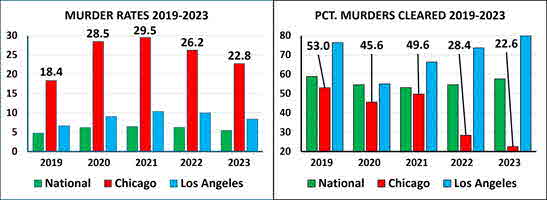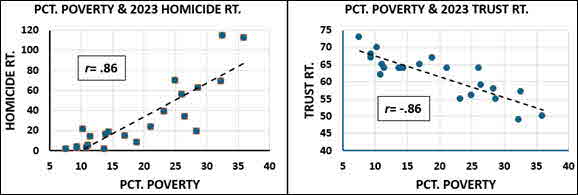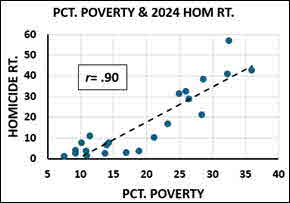|
Posted 6/22/25
MORE POVERTY, LESS TRUST
Citizens who most need the cops trust them the least

For Police Issues by Julius (Jay) Wachtel. Our lead graphic uses UCR and NIBRS data published by the Murder Accountability Project to illustrate Chicago’s long-standing problem with crime, and particularly of the violent kind. In 2018, the “windy city’s” chronically high murder rate and abysmally low solution drove its leaders to ask the Police Executive Research Forum to probe things and offer advice. Was there anything that could realistically be done?
Funded in part by a Federal grant, a team of specialists spent a year reviewing Chicago PD’s investigative practices, analyzing its material and personnel resources, examining examples of past casework, and interviewing detectives and staff members. A detailed assessment offering eighty-nine specific recommendations was delivered in 2019. Best we can tell, that tome wasn’t publicly released. But on April 24, 2025 CPD posted an 87-page report that “highlights instrumental changes the Department has made to align with recommendations in key areas of staffing, organizational structure, oversight, training, policies and procedures, and equipment and technology.” Readers get a step-by-step tour of just what the beset agency‘s done to implement PERF’s recommendations.
Click here for the complete collection of crime & punishment essays
Has it helped? Check out our updated version of the graphics:

In 2023, four years into the re-do, the city’s murder rates were nearly one-quarter (23.9 percent) worse than in 2019. And the percent of homicides cleared correspondingly plunged. While 2024 clearance rates aren’t yet in, Chicago PD reported 573 murders in 2024, yielding a per/100,000 homicide rate of 21.1. That’s a bit “improved” from 2023 but still way beyond the pale.
Chicago PD’s report doesn’t get into the “numbers.” But it does offer abundant praise for PERF’s team, without whom “the Department and Bureau of Detectives could not have advanced as rapidly and successfully in implementing these reforms to homicide investigations.”
Job done, right? Well, not so fast. “I get that they’re understaffed. But at the same time, where’s my justice?” That lament was recently conveyed to the Chicago Sun-Times by a rideshare driver who was shot and seriously wounded during a 2021 robbery. That “understaffing” (and its consequences) also catches heat from the cops. Here’s what a retired detective had to say. “In some districts, in the summer, you might be getting five or seven shooting cases a week. Even if you wanted to run down every case like [it was] a murder, there’s just no time to do it….”
According to the Sun-Times, compared to L.A., only half as many of Chicago’s cops are detectives. That shortage of investigators supposedly contributes to poor solution rates and high levels of crime. Indeed, increasing the number of detectives was a key element of PERF’s plan. Chief Ursitti told reporters earlier this year that a team of detectives had recently been formed to specialize in shooting investigations, and that the unit’s size would expand.
To be sure, more detectives can prove useful. Detailed sweeps of crime scenes and the execution of search warrants and such can yield valuable evidence. But there’s no substitute for having citizens promptly alert police when things go astray. Witness testimony is always crucial, and picking out evildoers from a lineup can’t be done by a machine. Of course, Chicago well knows that citizen cooperation is key. In fact, during 2018-2023 the city paid a private firm to survey citizens about their feelings of safety and, just as importantly, of their trust in the police.
 Might how citizens feel about cops affect their peace-keepers’ end product? We used the r correlation statistic to assess the relationship between the trust that residents expressed in the police, district by district, and homicide rates per 100,000 pop. (trust data is from 2023, the most recent year available.) The r scale ranges from zero, meaning no relationship between measures (“variables”) to one, meaning that they move in lockstep. Here the outcome, r=-.76, suggests that trust and homicide are strongly linked. It’s negative: as scores for one increase, scores for the other decrease. Grab a look. Each district is a “dot.” Those on the low end of the trust scale (left side) have mostly high homicide rates, while those at the high end of the trust scale (right side) mostly enjoy low homicide rates. Might how citizens feel about cops affect their peace-keepers’ end product? We used the r correlation statistic to assess the relationship between the trust that residents expressed in the police, district by district, and homicide rates per 100,000 pop. (trust data is from 2023, the most recent year available.) The r scale ranges from zero, meaning no relationship between measures (“variables”) to one, meaning that they move in lockstep. Here the outcome, r=-.76, suggests that trust and homicide are strongly linked. It’s negative: as scores for one increase, scores for the other decrease. Grab a look. Each district is a “dot.” Those on the low end of the trust scale (left side) have mostly high homicide rates, while those at the high end of the trust scale (right side) mostly enjoy low homicide rates.
Point made? Well, not so fast. Problem is, that seemingly strong statistical relationship between trust and homicide, which is consistent with the former’s role as a “cause” of the latter, may have actually been produced by a third factor with which both measures are strongly associated. Indeed, whenever the “effect” is violent crime, we’ve always turned to poverty as the likely suspect.

Check the scattergram on the left. Poverty’s relationship with homicide yields a pronounced r of .86: as poverty goes up, so do murders, and nearly in lockstep. What’s more, the relationship between poverty and trust (right graphic) is also very strong. At r= -.86 it’s (coincidentally) of the same magnitude but negative, meaning that as poverty increases, trust systematically declines.
Poverty is strongly associated with both homicide and trust. Might that exaggerate the magnitude of trust’s seeming relationship with homicide? To find out we turned to “partial correlation,” a technique that strips away the influence of a third variable from a two-way relationship. Here’s the result:

- Trust and homicide: Trust and homicide (left table) have a strong r of -.76. But when the influence of poverty is removed (right table), their relationship plunges to a measly -.08. It literally disappears.
- Poverty and homicide: When the influence of trust is removed, the relationship between poverty and homicide drops from a weighty .86 (left table) to a lesser but still substantial .62 (right table.)
- Poverty and trust: When the influence of homicide is removed, the relationship between poverty and trust drops from -.86 (left table) to a still-substantial -.62 (right table).
 Lack of trust in the police might well be another of poverty’s unholy effects. But put trust aside for the moment. Homicide-wise, poverty clearly has the leading role. And in Chicago, its effects may have become even more pronounced last year. This scattergram compares percent in poverty and 2024 district homicide rates. Look at those dots! (again, each is a district.) This time the relationship between poverty and homicide produces an r of .90, only inches away from a “perfect” 1.0. (Note: According to a CPD news release, homicides fell from 620 in 2023 to 573 in 2024. Our district-by-district count using the city’s “crime dashboard” produced 586 homicides for 2024. So that’s the number we used. Thankfully, it’s only a small difference. Alas, there were no trust scores for 2024. But that’s for another day!) Lack of trust in the police might well be another of poverty’s unholy effects. But put trust aside for the moment. Homicide-wise, poverty clearly has the leading role. And in Chicago, its effects may have become even more pronounced last year. This scattergram compares percent in poverty and 2024 district homicide rates. Look at those dots! (again, each is a district.) This time the relationship between poverty and homicide produces an r of .90, only inches away from a “perfect” 1.0. (Note: According to a CPD news release, homicides fell from 620 in 2023 to 573 in 2024. Our district-by-district count using the city’s “crime dashboard” produced 586 homicides for 2024. So that’s the number we used. Thankfully, it’s only a small difference. Alas, there were no trust scores for 2024. But that’s for another day!)
Back to trust. According to the Sun-Times, “Chicago police have a low level of trust among the public, particularly in communities where most shootings happen.” Its probe discovered that “about 1,500 nonfatal shootings since 2018 were dropped because the victims of those shootings didn’t want to help with the investigation.” Bottom line: poverty and homicide really are that proverbial “horse and carriage.” And trust is clearly along for the ride. Problem is, residents of stricken areas know full well that calling in the “Mounties” could easily place them – and their families – at grave personal risk. So of course they’d think twice before helping the cops.
Be sure to check out our homepage and sign up for our newsletter
Is that frustrating? Ask the rideshare driver.
What can be done? Tweaking police deployment and such might help. But don’t expect miracles. As we’ve often argued, what’s really needed is a socio-economic transformation of poverty-stricken neighborhoods. Here’s an outtake from “Let’s Stop Pretending”:
To be sure, the craft of policing can always improve. But poverty and the things that come with poverty can make even “routine” policing exasperating. As we recently noted in “Fix Those Neighborhoods!” and “Human Renewal,” making a real difference would require a concerted effort to provide needy areas with resources and services that might prevent the next Adam Toledo from running around with an armed gang-member at one in the morning. That calls for major investments in child care, tutoring, job training, apprenticeships, health care and housing. And yes, it would be expensive, and yes, residents of better-off areas might complain.
What can you do? Pass it on!
Did you enjoy this post? Be sure to explore the homepage and topical index!
Home Top Permalink Print/Save Feedback
RELATED POSTS
Neighborhoods special topic
2024 Crime and Punishment posts Let’s Stop Pretending Fix Those Neighborhoods!
Human Renewal
|